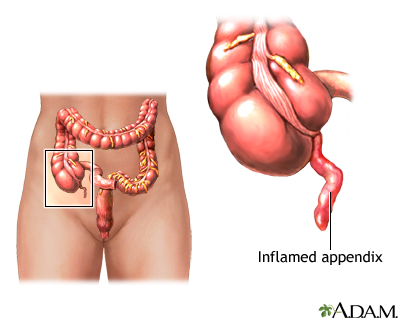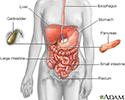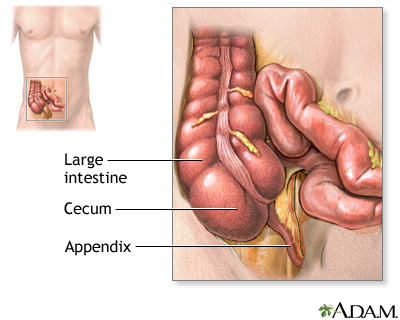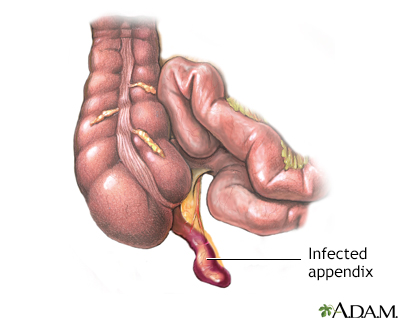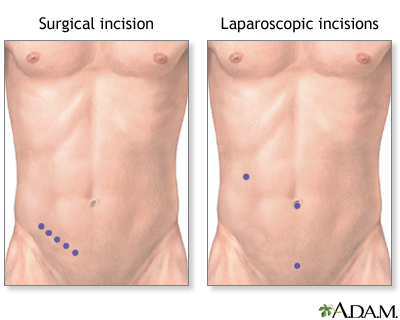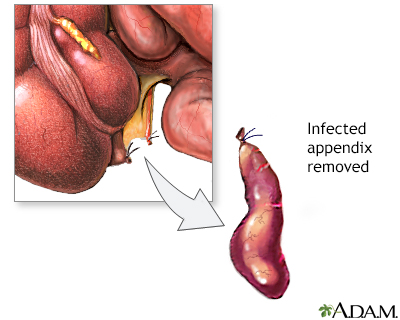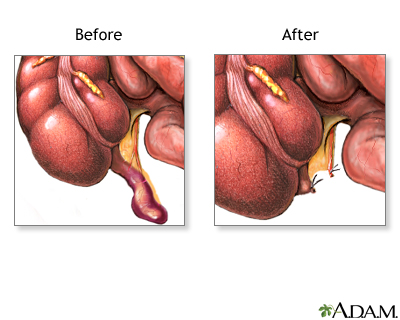Appendicitis
Appendicitis is a condition in which your appendix gets inflamed. The appendix is a small pouch attached to the end of the large intestine.
Causes
Appendicitis is a very common reason for emergency surgery. The problem most often occurs when the appendix becomes blocked by feces, a foreign object, a tumor or a parasite in rare cases.
Tumor
A tumor is an abnormal growth of body tissue. Tumors can be cancerous (malignant) or noncancerous (benign).
Read Article Now Book Mark Article
Appendicitis
The appendix is a small finger-shaped tube that branches off the first part of the large intestine. The appendix can become inflamed or infected causing pain in the lower right part of the abdomen.
Symptoms
The symptoms of appendicitis can vary. It can be hard to detect appendicitis in young children, older people, and women of childbearing age.
The first symptom is often pain around the belly button or mid upper abdomen. Pain may be minor at first, but becomes more sharp and severe. You may also have a loss of appetite, nausea, vomiting, and a low-grade fever.
The pain tends to move into the right lower part of your belly. The pain tends to focus at a spot directly above the appendix called McBurney point. This most often occurs 12 to 24 hours after the illness starts.
McBurney point
Abdominal point tenderness is the localized pain you feel when pressure is placed over a certain part of the belly area (abdomen).

Your pain may be worse when you walk, cough, or make sudden movements. Later symptoms include:
- Chills and shaking
- Hard stools
- Diarrhea
- Fever
- Nausea and vomiting
Exams and Tests
Your health care provider may suspect appendicitis based on the symptoms you describe.
Your provider will do a physical exam.
- If you have appendicitis, your pain will increase when your lower right belly area is pressed.
- If your appendix has ruptured, touching the belly area may cause a lot of pain and lead you to tighten your muscles.
- A rectal exam may find tenderness on the right side of your rectum.
A blood test will often show a high white blood cell count. Imaging tests that may help diagnose appendicitis include:
-
CT scan of the abdomen
CT scan of the abdomen
An abdominal CT scan is an imaging test that uses x-rays to create cross-sectional pictures of the belly area. CT stands for computed tomography....
 ImageRead Article Now Book Mark Article
ImageRead Article Now Book Mark Article -
Ultrasound of the abdomen
Ultrasound of the abdomen
Abdominal ultrasound is a type of imaging test. It is used to look at organs in the abdomen, including the liver, gallbladder, pancreas, and kidneys...
 ImageRead Article Now Book Mark Article
ImageRead Article Now Book Mark Article
Treatment
Most of the time, a surgeon will remove your appendix as soon as you are diagnosed.
Remove your appendix
An appendectomy is surgery to remove the appendix.

If a CT scan shows that you have an abscess, you may be treated with antibiotics first. You will have your appendix removed after the infection and swelling have gone away.
Abscess
An abscess is a collection of pus in any part of the body. In most cases, the area around an abscess is swollen and inflamed.

The tests used to diagnose appendicitis are not perfect. As a result, the operation may show that your appendix is normal. In that case, the surgeon will remove your appendix and explore the rest of your abdomen for other causes of your pain.
Outlook (Prognosis)
Most people recover quickly after surgery if the appendix is removed before it ruptures.
If your appendix ruptures before surgery, recovery may take longer. You are also more likely to develop problems, such as:
- An abscess
- Blockage of the intestine
- Infection inside the abdomen (peritonitis)
- Infection of the wound after surgery
When to Contact a Medical Professional
Contact your provider if you have pain in the lower-right portion of your belly, or other symptoms of appendicitis.
Pain
Abdominal pain is pain that you feel anywhere between your chest and groin. This is often referred to as the stomach region or belly.

References
Carlberg DJ, Himelfarb NT. Acute appendicitis. In: Walls RM, ed. Rosen's Emergency Medicine: Concepts and Clinical Practice. 10th ed. Philadelphia, PA: Elsevier; 2023:chap 79.
Garcia EM, Camacho MA, Karolyi DR, et al. ACR appropriateness criteria right lower quadrant pain -- suspected appendicitis. J Am Coll Radiol. 2018;15(11S):S373-S387. PMID: 30392606 pubmed.ncbi.nlm.nih.gov/30392606/.
Rosenthal MD, Sarosi GA. Appendicitis. In: Feldman M, Friedman LS, Brandt LJ, eds. Sleisenger and Fordtran's Gastrointestinal and Liver Disease: Pathophysiology/Diagnosis/Management. 11th ed. Philadelphia, PA: Elsevier; 2021:chap 120.
Sifri CD, Madoff LC. Appendicitis. In: Bennett JE, Dolin R, Blaser MJ, eds. Mandell, Douglas, and Bennett's Principles and Practice of Infectious Diseases. 9th ed. Philadelphia, PA: Elsevier; 2020:chap 78.
-
Anatomical landmarks adult - front - illustration
There are three body views (front, back, and side) that can help you to identify a specific body area. The labels show areas of the body which are identified either by anatomical or by common names. For example, the back of the knee is called the “popliteal fossa,” while the “flank” is an area on the side of the body.
Anatomical landmarks adult - front
illustration
-
Digestive system - illustration
The esophagus, stomach, large and small intestine, aided by the liver, gallbladder and pancreas convert the nutritive components of food into energy and break down the non-nutritive components into waste to be excreted.
Digestive system
illustration
-
Appendectomy - series
Presentation
-
Appendicitis - illustration
The appendix is a small finger-shaped tube that branches off the first part of the large intestine. The appendix can become inflamed or infected causing pain in the lower right part of the abdomen.
Appendicitis
illustration
-
Anatomical landmarks adult - front - illustration
There are three body views (front, back, and side) that can help you to identify a specific body area. The labels show areas of the body which are identified either by anatomical or by common names. For example, the back of the knee is called the “popliteal fossa,” while the “flank” is an area on the side of the body.
Anatomical landmarks adult - front
illustration
-
Digestive system - illustration
The esophagus, stomach, large and small intestine, aided by the liver, gallbladder and pancreas convert the nutritive components of food into energy and break down the non-nutritive components into waste to be excreted.
Digestive system
illustration
-
Appendectomy - series
Presentation
-
Appendicitis - illustration
The appendix is a small finger-shaped tube that branches off the first part of the large intestine. The appendix can become inflamed or infected causing pain in the lower right part of the abdomen.
Appendicitis
illustration
Review Date: 5/2/2023
Reviewed By: Michael M. Phillips, MD, Emeritus Professor of Medicine, The George Washington University School of Medicine, Washington, DC. Also reviewed by David C. Dugdale, MD, Medical Director, Brenda Conaway, Editorial Director, and the A.D.A.M. Editorial team.


